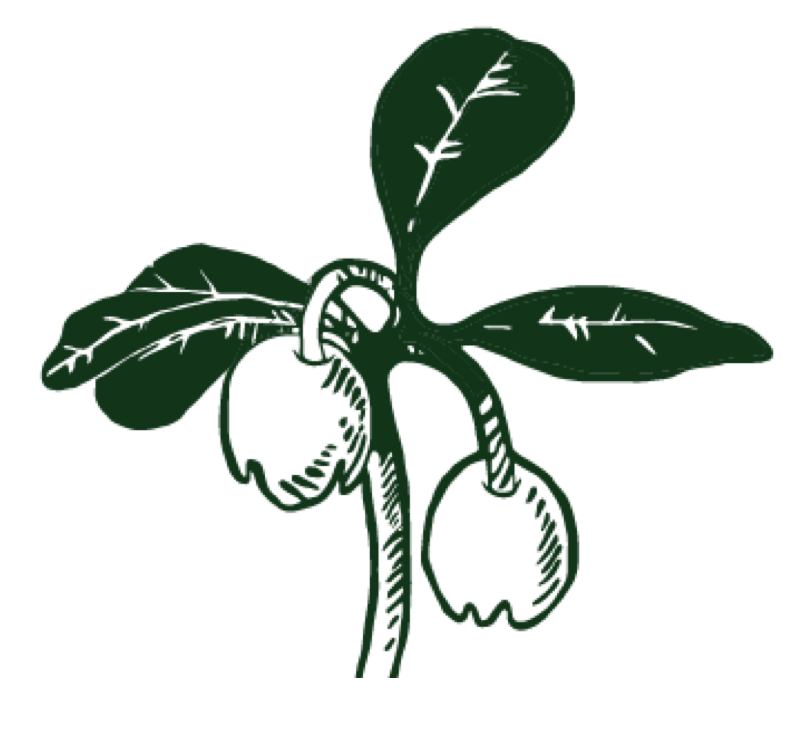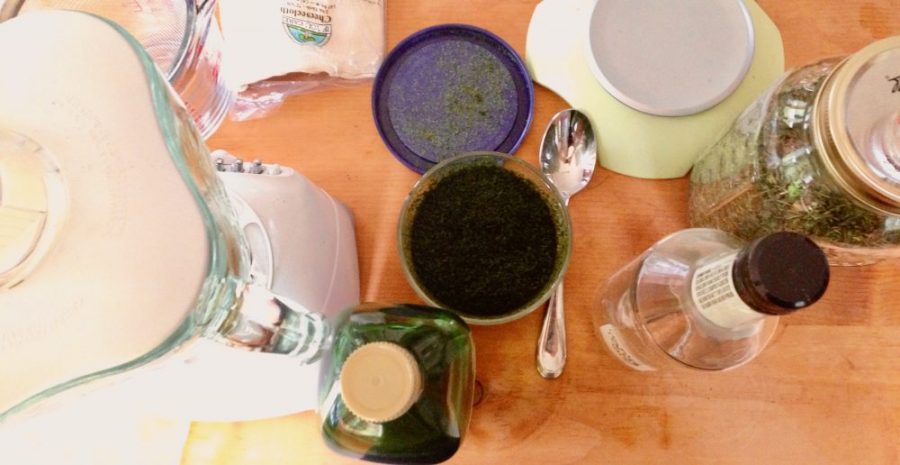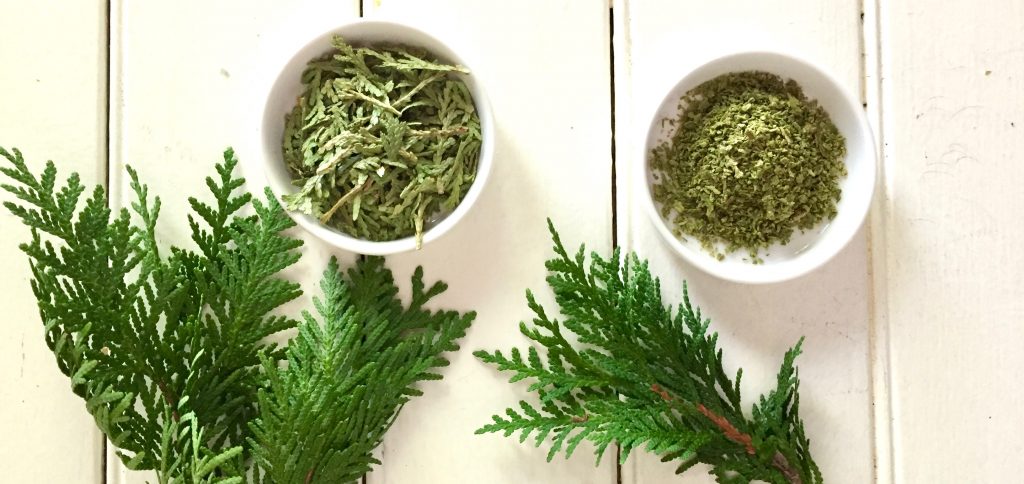Repost updated with remedy-making video links!
To be honest, oil is not a great solvent for extracting herbs (alcohol, water, and vinegar – in that order – tend to work better). It also has a greater potential to go bad via rancidity, mold, or bacteria, including botulism. Yet, we often use herb-infused oils for topical remedies because oil feels much nicer on the skin, for glide and moisture, and can be used as a base oil ingredient in skincare recipes. Infused oils can also be used “as is” for many health concerns – warmed mullein oil dropped in the ear for earaches, St. John’s wort oil applied along nerve pain or for bedsores, calendula oil on sore mama nipples, eczema, and rashes. Or, you can use your herbal oil in skincare recipes – salves, lip balms, massage oils, creams, etc.
Note: Herbal oils (herb-infused oils) are NOT the same as essential oils (EOs). An EO is highly concentrated via distillation and requires an expensive still. Due to their potency, an EO’s value is often increased or changed compared to home herbalist preparations of the same plant. They’re more apt to pose health risks. EOs are potentially extremely toxic when taken internally, particularly in doses more than a drop or two. Even topically, most EOs need to be diluted to about 2%. In contrast, herbal oils (herb-infused oils) are much milder, gentler, bring out different constituents, and have a less fragrance. You can certainly dilute an EO in an herbal oil to combine their healing effects.
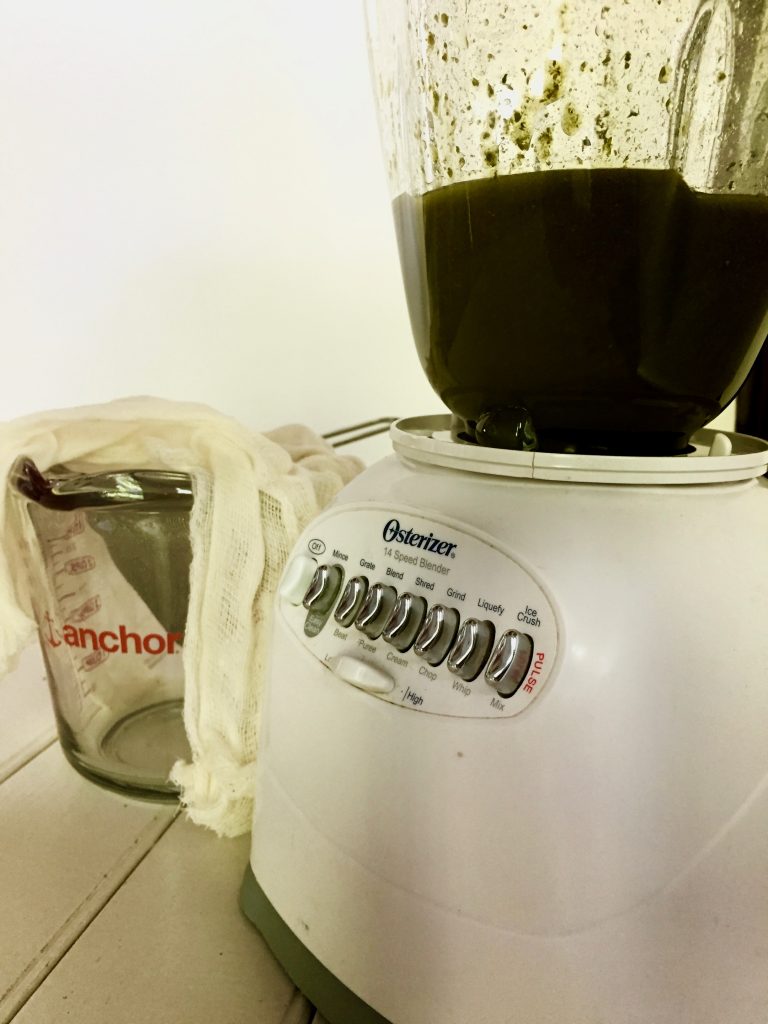
The Technique
There are MANY methods for making an herbal oil. Some of it is personal preference. Also, some herbs extract better through different methods.
Alcohol Intermediary Oil
1 day with alcohol & a blender (courtesy of Michael Moore)
This technique is unusual in that it involves alcohol and can only be done with dry plant material. However, the little bit of alcohol does an excellent job enhancing the extraction of constituents, and it also is far less likely to go bad (because you’re using dry rather than fresh herb, and because the alcohol helps disinfect and preserve the plant). Bonus: It’s ready within one day!
- 1 oz of dried herb, ground coarsely in the blender or food processor
- 1/2 oz whole grain alcohol (vodka can be substituted, but it will add water to the mix)
- 7 to 8 oz olive or other carrier oil
In a glass container with a tight lid, mix dried herb with alcohol. It will be the consistency of slightly damp soil. Let sit, covered, for about one day.
Place the herb-alcohol mix into a blender, add oil, and slowly blend the mixture. Increase the speed. Let blend until the blender gets warm, about 5 minutes.
Strain through cheesecloth or a cloth to desired clarity. If desired, filter again through a coffee filter, changing as needed.
Store in glass in a cool, dark place. Should keep for 6-12 months, sometimes longer.
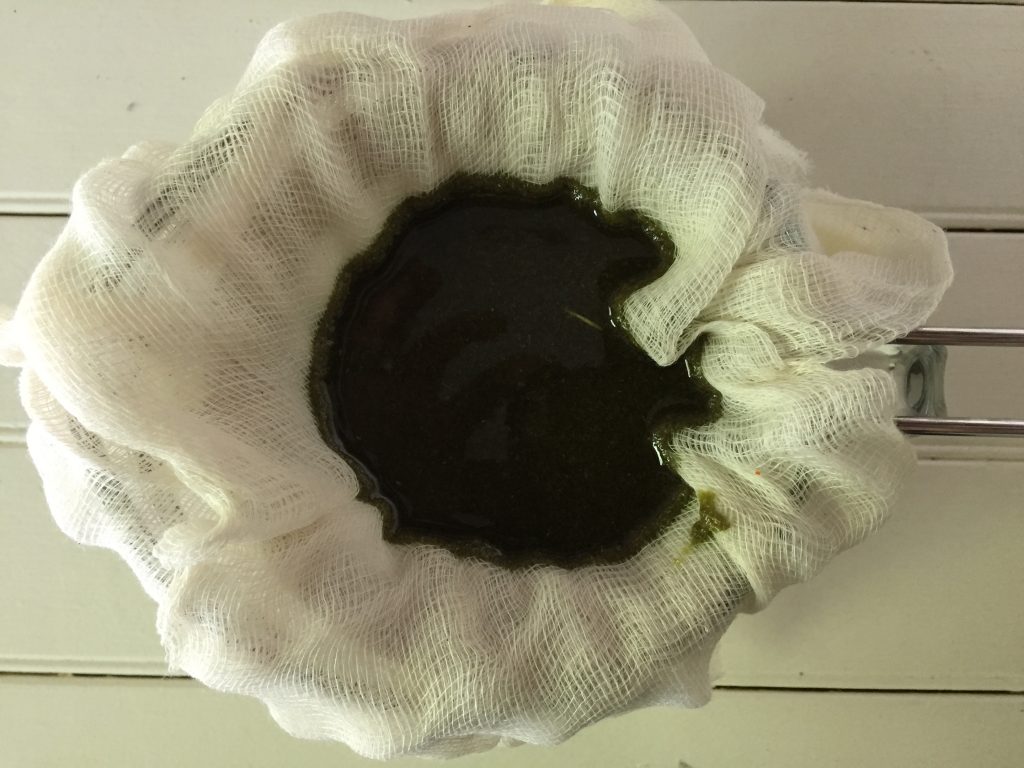
Enjoy this video I did with Mountain Rose Herbs that shows you how to do an alcohol-intermediary oil ~
Note: For calendula, I often like to combine this method with Simple Method #2. After I blend it in the blender, I put it all in a mason jar and let it sit in the car for a few days, then strain it out.
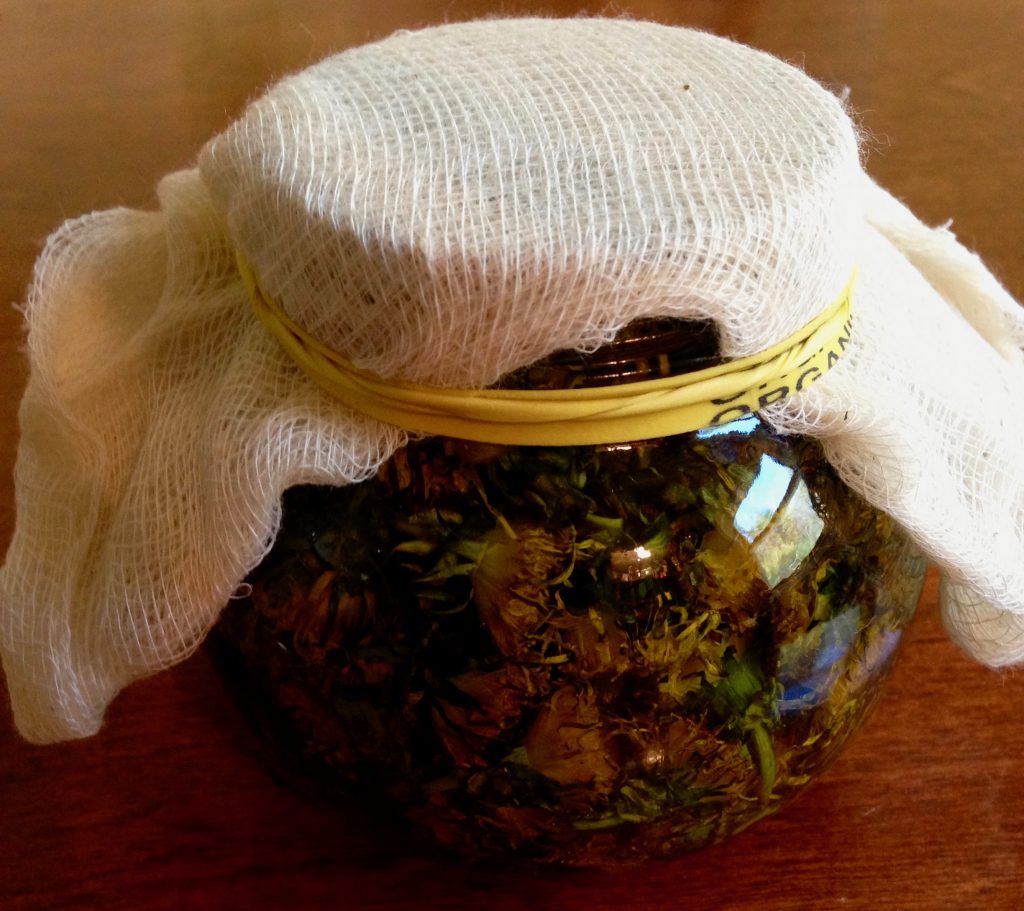
Simple Method #1: Basic Maceration
2 weeks in mason jar
In this method, you simply cover herbs and macerate them in oil. Fresh or dry. These measurements are approximate for a pint jar. It’s most important to make sure your herbs are always submerged in oil. You’re aiming for about 1:5 to 1:8 ratio for dry herb and 1:2 to 1:4 ratio for fresh. (Ratio = weight of herb:volume oil)
- 1-2 ounces dry herb or 3-5 ounces of fresh or fresh wilted herb
- Enough olive or other carrier oil to completely cover the herbs (about 10-15 ounces)
Place all ingredients in a mason jar and leave in a warm spot for 2 weeks. Shake daily. For fresh herbs, you may cover with cheesecloth and stir daily to help evaporate some moisture. Strain through cheesecloth or muslin. (Watch for mold if using fresh herbs.) Store in glass in a cool, dark place. Should keep for 6-12 months but might go bad sooner.
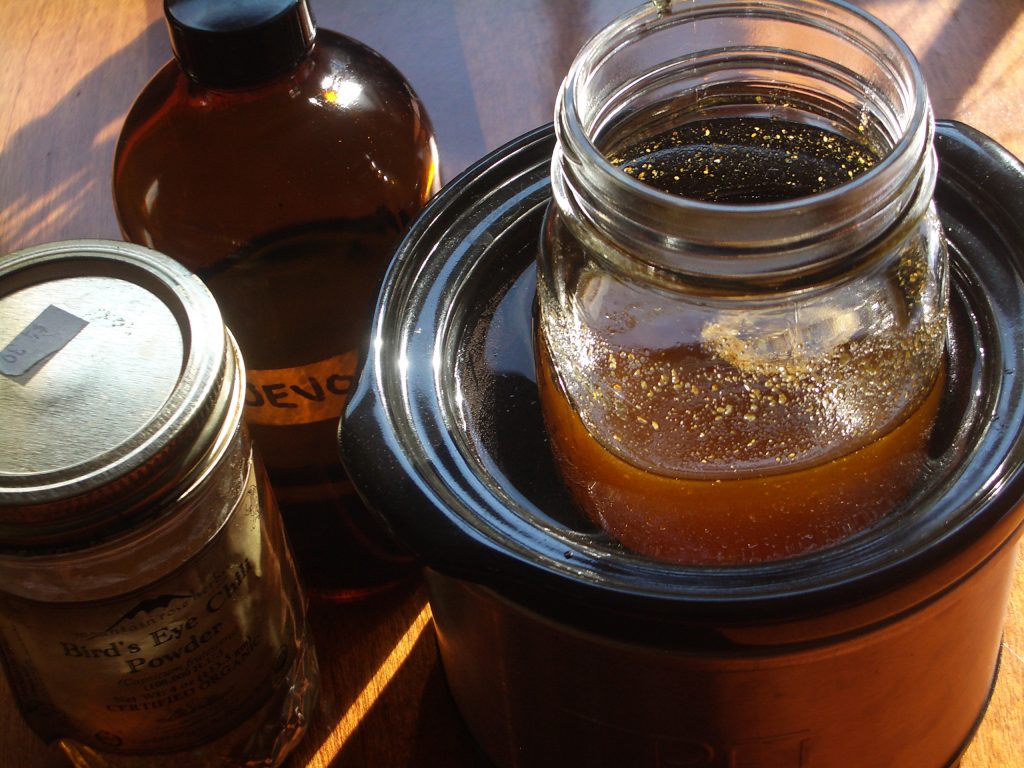
Simple Method #2: Heated Maceration
1 day on stove or in crock-pot, or a few days in a warm, sunny car
In this method, you heat your herb gently or repeatedly over the course of a few hours to a few days. Fresh or dry. These measurements are approximate for a pint jar. It’s most important to make sure your herbs are always submerged in oil. You’re aiming for about 1:5 to 1:8 ratio for dry herb and 1:2 to 1:4 ratio for fresh. (Ratio = weight of herb:volume oil)
- 1-2 ounces dry herb or 3-5 ounces of fresh or fresh wilted herb
- Enough olive or other carrier oil to completely cover the herbs (about 10-15 ounces)
Place ingredients in crock-pot or in pan on stove top. Bring to 90-100 degrees (this can be difficult to maintain with most kitchen equipment) or as low as possible. Let warm gently for 2-6 hours or overnight, stirring occasionally. Use caution not to cook the herbs or smoke the oil. A warm, sunny car can range from 100-200 degrees depending on the outdoor temps, sun exposure and where you place the oil (windshield, floor, shady spot). Strain with cheesecloth or muslin. Store in glass in a cool, dark place. Should keep for 6-12 months.
To Make a Salve...
Simply melt 1 ounce of beeswax down with 4 ounces of herb-infused oil in a double boiler to make 5 ounces of salve. Add essential oils as desired once it's off the heat but before it cools and hardens. You can easily multiply or divide this out based on how much salve you'd like to make. Enjoy this remedy-making video that I made with Mountain Rose Herbs ~
The Ingredients
Good Carrier Oils
Your carrier oil serves as your base oil. Any oil or fat can be used, but ideally you want one that extracts well, keeps well, has its own healing properties, and poses a low risk for allergies. Each option has its own pros and cons. Olive oil is the gold standard.
- Olive Oil – This is the base oil of choice for most herbal oils because it is relatively affordable, has a good shelf life, and is relatively therapeutic on its own.
- Coconut Oil – This is a creamy, saturated oil that is also relatively stable. It can be pricey. The consistency is unreliable - very solid in cool temps, liquid in warm temps - which is a disadvantage. Bonus: may have some sunscreen and antifungal properties.
- Grapeseed Oil – Another popular herbal oil base. Relatively good shelf life (still goes rancid faster than olive and coconut oil) and plain appearance and scent. But it is pricey and usually refined.
- Sunflower Oil - This is the only non-animal fat option that's locally available in most places. (If you're in California, you can get lots of oils locally made. Not so in "balmy" New Hampshire.) It's similar to grapeseed in properties but poses a bit more of an allergy risk.
- Sesame Oil – Popular in Ayurveda. Great for summer formulas due to light sunscreen properties.
Great Topical Herbs
These herbs can be used for infused oils and other topical remedies. Leaves and flowers most readily lend their properties to oil. You can use “harder” parts of the plants like roots, bark, and nuts, but they may not extract as well. If you only keep two herbal oils in your pantry, make them calendula and St. John’s wort. In my opinion, they’re the most useful and “miraculous.”
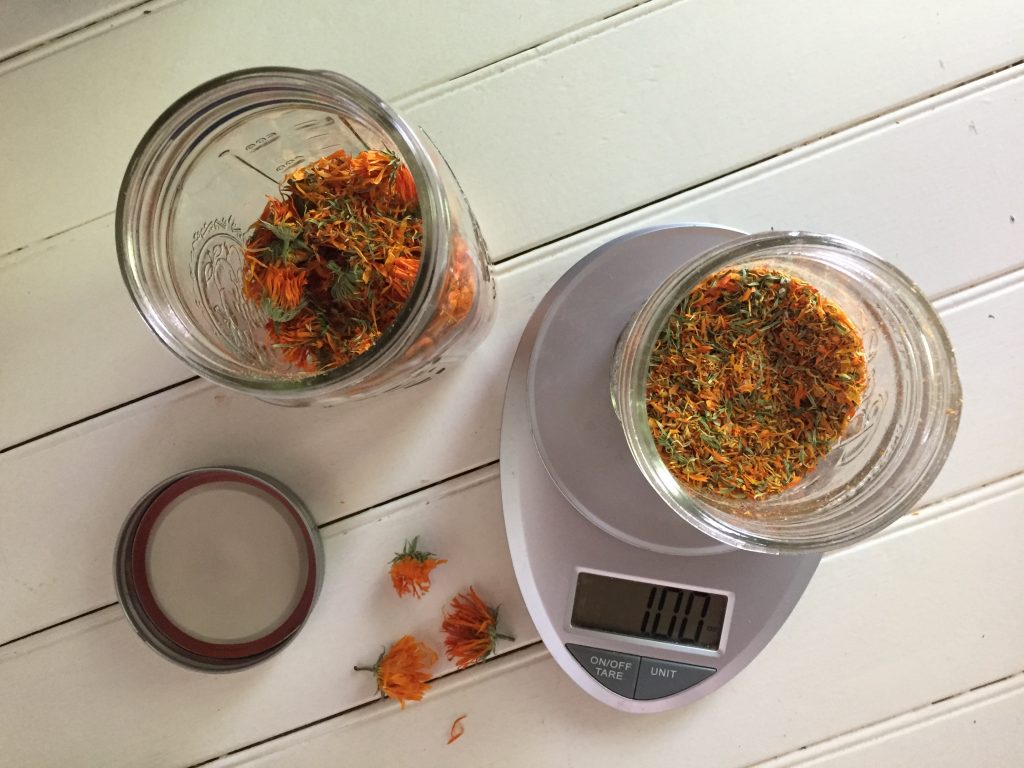
* May have slight SPF action.
- Calendula flowers (Calendula officinalis) – This is one of the most common herbal oils, and it can be purchased by the ounce in most natural food stores. Use dried bright yellow or orange blossoms, which make a golden oil. Calendula flowers have slight antimicrobial properties and are soothing to inflamed skin. It’s great in formula’s for baby’s skin, itches and rashes, superficial wounds, and some cases of dermatitis, eczema, and psoriasis. Dry or fresh (wilted) herbal oil infusion. Also try it as a wash (same as making a tea) or an herbal bath (add 1 quart of strong tea to bath).
- * St. John's wort flowers & buds (Hypericum perforatum) – The fresh yellow buds and flowers of this important weed yield an amazing crimson oil. Only fresh buds and flowers should be used (top bit of the plant, it’s ok if you get a few leaves and some stem), and the oil will be stronger if you let it infuse in the SUN (this is a SUN PLANT) for a few days or weeks. You can purchase St. John’s wort in 1 to 4 oz quantities in natural food stores. It’s an amazing medicinal oil for most skin conditions including burns, cuts, wounds, bedsores, radiation burns, etc. It can be applied along an inflamed nerve or muscle for pain including sciatica or shingles. (Self heal and lemon balm also help shingles/herpes.) It is reported to have mild sunscreen properties and also helps with sunburns. Fresh (no need to wilt) herbal oil infusion. Though drying, SJW tincture can be used in a pinch.
- Gotu Kola leaves (Centella asiatica) – The dried leaves of this ivy-like vine make a vibrant green oil (it does not color the skin). Gotu kola is a wound healer and general cure-all for circulation, collagen support, and the nervous system. We are seeing it more in formulas for varicose and spider veins, cellulite, skin imperfections, and wrinkles. It is occasionally available in natural food stores in jojoba or other carrier oil. Dry herbal oil infusion. Not local, but it can be grown as an annual or indoors.
- Plantain (Plantago spp.), Chickweed (Stellaria spp.), and Cleavers (Galium spp.) leaves – These three miracle weeds are usually only used fresh (slightly wilted) in classic folk herbalism. The three can be used separately or together for wound healing and itchy skin including eczema, dermatitis, psoriasis, and poison ivy. Fresh (wilted) herbal oil infusion. I love plantain oil or salve, and I also combine plantain oil with yarrow tincture in a roll on to shake and apply to bug bites. Plantain works better than calendula for itches and rashes due to bug bites and poison ivy. These herbs make lovely fresh poultices for a variety of irritated skin conditions, bug bites, stings, poison ivy, rashes, etc. Simply mash them up with a bit of water and plaster them to the skin. Just chew a plantain leaf and apply it to bee stings and bug bites for healing in a jiffy.
- * Comfrey leaf (Symphytum officinale, S. x uplandicum) – This is a classic herb for wound healing and strengthening the skin. The primary known constituent allantoin is a cell proliferative and may or may not be extracted in oil (modern science says it’s water soluble only – more so in hot water – yet herbalists have traditionally used in oil-based products). It has a reputation for speeding bone healing after the bone has been set, too. Warning: It’s fast, but not sophisticated (gotu kola, calendula, and St. John’s wort are better for good quality remodeling of the tissue). It’s also not antimicrobial and can seal in infections. Do not use for deep wounds. Comfrey might be even more useful topically for bumps, bruises (in place of arnica), sprains, strains, arthritis, etc. Dry herbal oil infusion. Note: Internal use is controversial. Comfrey also makes a great wash, fresh or dry poultice. Taking it internally is controversial due to liver toxins in the plant. Some of these toxins can also absorb through the skin, but the risk is much lower.
- Thuja leaf/needles (Thuja spp.) – An excellent herb for “killing critters” including bacteria, fungus, and viral infections including HPV/warts (though fresh celandine leaf poultice is even better for warts). Note: Internal use is controversial except in homeopathic or drop doses. Thuja also makes a great alcohol or vinegar extract to apply topically, as well as a bath infusion.
- * Chaparral (Larrea tridentata) – Chaparral is a supreme summer skin herb that grows prolifically in the southwest. It seems to have some sun-protective properties as well as antioxidants that may be helpful for post-burn healing. Chaparral is also amongst our best herbal antifungals, making it a nice choice for foot fungus and other “icky critter” salves. (If you’d like, you can combine it with oregano, lavender, sage, thyme, thuja, or other anti-fungal/bacterial infused oils… a few drops of essential oil would work nicely, too.) Dry herbal oil infusion. Note: Internal use is controversial. Also consider chaparral as a wash or soak. For foot fungus, make a foot bath. For sunburn, make a tea, cool it in the fridge, and spray it as needed.
Infused Oil Cautions: Avoiding Microbial Growth
Many microbes thrive in the anaerobic environment that oils provide. Without harsh or synthetic preservatives, infused oils and products made from them can potentially harbor bacteria, mold, etc. Of particular concern is the botulism toxin, which can exist on almost any plant matter (roots, flowers, leaves). This is more of a concern for oils that are consumed (basil or garlic oil, for example) than ones put on the skin, and it is not all that likely to occur. However, it can happen. Infused oils made with fresh plant material are at a particularly higher risk of growing nasty critters. You may want to stick to infusing oils with dried herbs; however, some herbs are only useful when fresh (St. John’s wort, chickweed, plantain, cleavers). Reduce the risk: Don’t let your herb sit around for more than two weeks before straining. And, wilt particularly juicy plants to 1/2 their weight before you add oil. You can also use natural and semi-natural preservatives including vitamin E (for rancidity), grapefruit seed extract (not as natural as it claims to be), benzoin, and essential oils like rosemary.
Maria runs Wintergreen Botanicals Herbal Clinic & Education Center in Allenstown. She offers classes and health consultations both on location and online/distance.
The statements made on this blog have not been evaluated by the FDA and are not intended to diagnose, prescribe, recommend, or offer medical advice. Please see your health care practitioner for help regarding choices and to avoid herb-drug interactions.
